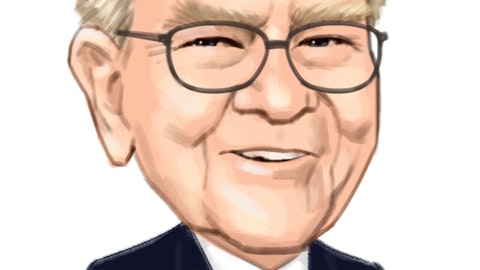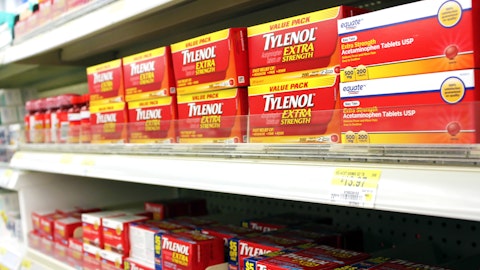The image below shows the 10 year cumulative returns of Johnson & Johnson (NYSE:JNJ) and the S&P 500 (SPY):

Source: Data from Yahoo! Finance
$1.00 invested in Johnson & Johnson on 1/27/2006 is worth $2.33 versus $1.82 for the same investment in SPY (both include reinvested dividends).
A large part of Johnson & Johnson’s outperformance over the last decade is because the stock fell less during the Great Recession (the red bars in the image above).
There are plenty of investments that outperformed Johnson & Johnson over the last decade – but beating the market is nothing to sneeze at.
There’s a hidden value to Johnson & Johnson stock not reflected in its return…
The company is an exceptionally low risk investment. Compare Johnson & Johnson’s stock price standard deviation to that of the S&P 500’s over the last 10 years:
– S&P 500 standard deviation of 20.7%
– Johnson & Johnson standard deviation of 16.3%
It’s true, standard deviation is not real risk, but it is a proxy for risk that is a good predictor of how easy or difficult a stock will be to hold.
The lower the standard deviation, the lower (on average) declines during recessions – and the less likely investors are to panic at the worst possible time.
Johnson & Johnson has delivered greater returns with lower risk as compared to the S&P 500 over the last decade.
That’s a claim few businesses can make.
At the same time, Johnson & Johnson is one of the most popular healthcare stocks among smart money investors. A total of 74 funds among those tracked by Insider Monkey reported long positions in the company with a total value of $3.93 billion as of the end of September, which compares to 78 investors holding stakes worth $4.38 billion in aggregate a quarter earlier. Billionaire Ken Fisher’s Fisher Asset Management held 10.69 million shares of Johnson & Johnson at the end of the third quarter.
Get To Know Johnson & Johnson
Johnson & Johnson was founded in 1886. Since that time, Johnson & Johnson has grown to become the largest health care business in the world.
The company currently has a market cap of nearly $280 billion and generated $17.4 billion in adjusted earnings in fiscal 2015.
Success is nothing new to Johnson & Johnson. The company has paid increasing dividends for 53 consecutive years.

Source: Johnson & Johnson Pharmaceutical Presentation, slide 21
Johnson & Johnson’s long dividend history makes it 1 of 17 Dividend Kings. Dividend Kings are stocks with 50+ consecutive years of dividend increases – twice the minimum amount needed to be a Dividend Aristocrat.
Johnson & Johnson’s consistency comes from its wide diversification within the health care industry.
The company operates in 3 segments. The percentage of total sales each segment generated in fiscal 2015 is shown below:
– The consumer segment generated 19% of total sales
– The pharmaceutical segment generated 45% of total sales
– The medical devices segment generated 36% of total sales
Johnson & Johnson’s diversification within the health care industry provides the company with stable cash flows.
In addition to diversification within the health care industry, Johnson & Johnson is also well diversified globally:
– United States sales were 51% of total sales in fiscal 2015
– Europe sales were 23% of total sales in fiscal 2015
– Asia-Pacific, Africa sales were 18% of total sales in fiscal 2015
– Western Hemisphere (excluding U.S.) sales were 9% of total sales in fiscal 2015
Follow Johnson & Johnson (NYSE:JNJ)
Follow Johnson & Johnson (NYSE:JNJ)
Receive real-time insider trading and news alerts
Consumer Segment Overview
Johnson & Johnson (NYSE:JNJ)’s consumer segment is its smallest. While the consumer segment may be small in comparison to Johnson & Johnson’s other segments, it generated $13.5 billion in sales in fiscal 2015.
The consumer segment controls many well-known brands. The image below shows a sampling of the company’s consumer brands:

Source: Johnson & Johnson Canada
Johnson & Johnson’s consumer segment generates about 65% of sales internationally, with 35% coming in the US.
Pharmaceutical Segment Overview
The company’s pharmaceutical segment is its largest, generating 45% of total company revenue.
Johnson & Johnson’s top 5 pharmaceuticals based on percent of pharmaceutical sales generated in fiscal 2015 are shown below:
- Remicade generated 21% of total pharmaceutical sales
- Stelara generated 8% of total pharmaceutical sales
- Zytiga generated 7% of total pharmaceutical sales
- Xarleto generated 6% of total pharmaceutical sales
- Invega Sustenna/Explion generated 6% of total pharmaceutical sales
Johnson & Johnson’s top 5 pharmaceutical products make up 48% of its total pharmaceutical revenue. Johnson & Johnson’s pharmaceutical portfolio is well diversified from a product standpoint.
The pharmaceutical segment is also well diversified geographically. The company generates 58% of pharmaceutical revenues in the US and 42% internationally.
Medical Devices Segment Overview
Johnson & Johnson’s medical devices segment is its second largest by revenue.
The segment generates 48% of revenue in the United States and 52% internationally.
The medical devices segment is divided into 5 separate divisions based on product use. Each division is shown below along with percent of total revenue generated for the segment in fiscal 2015:
– Cardiovascular Care generated 8% of total segment revenue
– Diabetes Care generated 8% of total segment revenue
– Orthopaedics generated 37% of total segment revenue
– Surgery generated 37% of total segment revenue
– Vision Care generated 10% of total segment revenue
Like Johnson & Johnson’s other segments, the medical devices segment is well diversified both geographically and across product lines.
Johnson & Johnson’s Competitive Advantage
A stock must have a strong competitive advantage (or several) positive dividend growth for 53 consecutive years and to be the largest business in its sector.
Johnson & Johnson’s has 3 broad competitive advantages that differentiate it from its competitors:
– Size/scale competitive advantage
– Research & development competitive advantage
– Brand competitive advantage
Johnson & Johnson’s size/scale competitive advantage is a result of it being the largest player in the health care industry. The company’s long history gives it excellent connections with suppliers and governments around the world. The company can keep input costs low by buying in far larger quantities than competitors can.
The company’s large size gives it a bigger research and development budget that its peers. Johnson & Johnson’s research and development spending by year is shown below:
– $9 billion in 2015
– $8.5 billion in 2014
– $8 billion in 2013
This spending has produced tangible results. Johnson & Johnson generates about 25% of revenue from products it has developed in the last 5 years. The company’s pharmaceutical portfolio in particular is benefiting from large research and development spending.
Johnson & Johnson commands premium pricing through its well-known brands. The company supports its consumer brands and pharmaceuticals with large advertising spending. The company spends around $2.5 billion every year on advertising.
Growth & Total Return Expectations
Johnson & Johnson realized 5.8% constant-currency adjusted earnings-per-share growth in fiscal 2015.
This is right in line with historical results for Johnson & Johnson. Over the last decade, the company has compounded earnings-per-share at 5.7% a year.
Going forward, I expect Johnson & Johnson to continue growing its earnings-per-share in the 5% to 7% a year range – which is in line with historical growth.
Johnson & Johnson’s growth will be driven by growing health care demand in emerging markets and aging populations in developed markets.
The health care industry benefits from aging populations as older people tend to require more health care. As the baby boomer generation in America continues to age, Johnson & Johnson will likely see its sales rise.
Johnson & Johnson stock currently has a dividend yield of nearly 3%. The company’s historical dividend yield over the last ~20 years is shown below:

Johnson & Johnson investors should expect total returns of 8% to 10% a year from the company from:
– 3% dividend yield
– 5% to 7% expected earnings-per-share growth
Valuation & Final Thoughts
With expected total returns of 8% to 10% a year, Johnson & Johnson will likely match the markets long-term total return average of around 9% a year – with less volatility.
As a result, Johnson & Johnson should trade for at least the same price-to-earnings multiple as the S&P 500 – but it doesn’t.
Johnson & Johnson (NYSE:JNJ) currently trades for an adjusted price-to-earnings ratio of 16.3 versus 20.1 for the S&P 500. The company appears somewhat undervalued at current prices.
Johnson & Johnson’s combination of a ~3% dividend yield, long history of success, and an extremely low stock price volatility make it a Top 20 stock using The 8 Rules of Dividend Investing.
The company makes an intriguing investment for risk-averse investors looking for growing income in the health sector.
Disclosure: None





